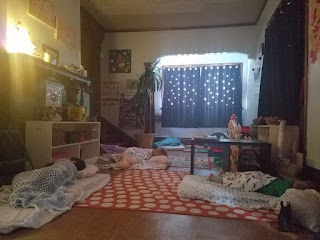I have recently learned that there are many childcare centers that terminate for things that are developmentally appropriate. One of our parents shared with me recently that the center her child was at before coming to us had such a policy for biting and that her 10-month-old was on bite number two, with the third bit meaning they would be terminated.
Parents are under enough stress without having to worry
about their whole life being disrupted because their infant behaves in a
developmentally appropriate way. I know
it is upsetting when your child gets hurt while at childcare. Over the years, I
have had many parents threaten to leave over their child being bitten. I feel these policies are a knee jerk
reaction to such threats.
Creating policy that punishes a family for their child
behaving like a child, is a missed opportunity. It is a missed opportunity to
educate parents on natural child development.
It is a missed opportunity to educate parents on why biting happens and
what to do when it happens. It is a
missed opportunity to educate parents to see what is often seen as misbehaving,
as what is really is, natural child development.
When one toddler hurts another, it is rarely, if ever, an
act of aggression. In this piece I am
going to use the word bite to stand in for all the words listed in the title to
avoid having to list them all the time. When we have a child who bites our
first step of action is to look at what was happening right before the
bite. There are some obvious reasons
like fighting over a toy or someone was in their way, and sometimes there seems
to be no cause.
One common reason for biting is frustration. Not necessarily
frustration at what just happened but built-up frustration. I’m sure most of us
can recall a time when we had a rough day and then snapped at someone for some
small infraction. The same thing happens
with toddlers, maybe their morning was rushed, and they didn’t like their
breakfast and one friend had taken a toy and now another friend looks like they
might take a toy and snap, they bite that friend. To the observer, it looks like they bit for
no reason, but that is not really the case.
Another common reason for biting is a lack of verbal
skills. We all know that in a toddler’s
brain, what they had 10 minutes ago is still theirs. They see another child start to pick up a toy
they had earlies and without the words to say “hey, that’s mine” they use the
tools they have and bite.
Curiosity is also another reason for biting. I have seen toddlers look at another child
and simply bit them just to see what happens.
Experimenting is what toddlers do and they don’t know that biting is
not an allowed form of experimentation. Just yesterday, I had a toddler who was
sitting near me, bend over and bite the tip of my slipper. This child was not
mad at me, this child was not wanting to hurt me, this child simply looked at
my slipper and thought “I wonder what it would feel like to bite that?”
None of these children are being bad, they are expressing
emotions, communicating and experimenting. Which is exactly what they are supposed to be
doing.
-


